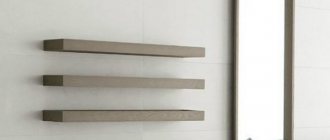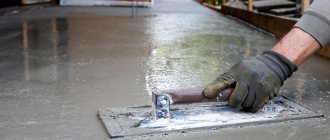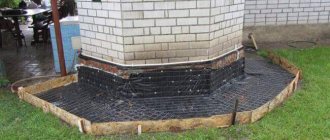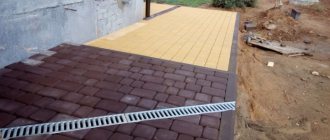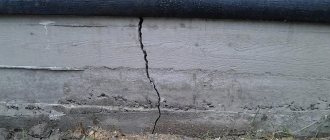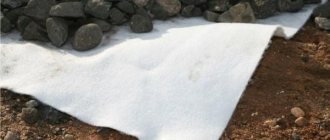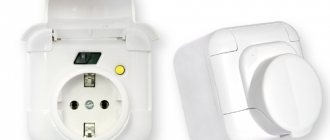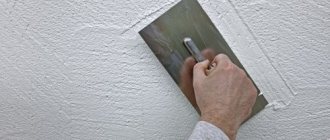Ironing with cement
If the technology for casting the blind area is incorrect, it begins to peel, crack, break, and become unusable. Destruction (destruction) will transfer to the foundation. To avoid this, you need to understand the weaknesses of concrete. Cement is highly sensitive to changes in hydrogen content from the average. Alkali and acid are equally destructive; it is necessary to carefully seal the blind area. A film is placed under it, the sides are covered with protective substances.
The water-cement index should tend to 0.2. For one part of cement there should be 0.2 parts of water. However, with this ratio the solution becomes too hard, so it is made 0.3 - 0.5. Excess water quickly reduces the strength of concrete. It is necessary to fill the blind area in segments; due to different shrinkage rates, long tapes will burst. Use fittings. Air is removed using manual vibrators.
A blind area made in this way will have sufficient strength. However, the top layer needs protection. This is due to the following two main aspects:
- mechanical;
- physical processes.
The blind area is affected by weather, cleaning tools, and the impact of shoes. The top layer wears away, reducing the thickness of the coating. The second is related to the process of concrete formation. Water turns out to be the lightest substance in the solution, so it is displaced to the surface. When evaporating, shells and pores remain; the deeper inside the concrete body, the smaller the pores. When water gets into the pores and freezes, it applies destructive force and crushes the concrete. Ironing will help eliminate the problem.
In what cases is reinforced concrete used?
During the operation of concrete, considerable dynamic loads are envisaged. Therefore, every good owner should know when to reinforce concrete.
The final strength of the material is determined by the density of the finished solution. The use of different fractions of sand and the correct ratio of fillers helps to increase this indicator. Due to the porous structure of the top layer, moisture penetrates into the monolith, causing destruction of the material. The danger lies in the freezing/thawing of internal crystals, which, when expanding, rupture the monolith.
Active chemicals also have a destructive effect on the outer layer. The result of unfavorable conditions and excessive loads are deep cracks and loss of strength in concrete. Ironing technology allows you to seal pores and cracks, ensuring the integrity of the structure.
Cement consumption per 1 m3 of solution
The procedure is carried out when performing finishing or construction work. This makes it possible to prevent surface destruction from moisture entering microcracks. To preserve the foundation of the building from premature wear, you need to reinforce the concrete on the blind area. This will strengthen the foundation, ensuring its long-term operation without expensive repairs.
Brief description of the process
Ironing is the treatment of concrete pavement with cement mortar. Cement, since it is heavier than water, penetrates into the pores and clogs them. The following indicators increase:
- strength;
- waterproofing.
Fragility and flaking disappear. In addition to cement, other components can be added to the mixture to improve the quality of the surface. Some can completely replace cement. However, the main purpose of ironing - clogging pores - must be achieved.
Types of compositions for ironing
The most common component is pure cement. It is better to take grade 400, 500. To reduce consumption, add sand. However, it must be clean, without clay impurities.
Even a small clay content in the solution greatly reduces the strength.
Water is used to separate sand from clay. After washing, the sand is dried and sifted through a sieve. Sand fractions should be medium to large.
The finer the sand, the more cement and water required.
You can use waste from industrial, mining, electrical, chemical and other industries. Some mixtures contain corundum, liquid glass, sodium aluminate. Plasticizers are added for plasticity. For example, by including 10% of the volume of the mixture with lime dough, a moving mass is obtained.
The mass of liquid glass is also 10%. After this coating, the surface becomes mirror-like. Sodium aluminate has water-repellent properties and acts as an antistatic agent.
Ironing methods
The choice of method depends on the technological process:
- dry;
- wet;
- using polymers.
If ironing is carried out immediately after pouring the blind area, we will use the dry method. This is the most reliable, simplest, when compared with others. If the concrete has hardened, only the second or third can be used. They are suitable for restoring a strength film that has been destroyed.
Dry ironing
The method is used during casting of the blind area. Before treatment, wait at least two hours to allow the solution to settle. Water appears on the surface. Prepare the working mixture. High grade cement is required - 400 and higher. If the cement has become caked from long-term storage, it must be kneaded and sifted through a sieve. The sieve cells are approximately 3 mm in size. If the cement is heavily caked, it will not be suitable for ironing. It can be used on the foundation, masonry mortar.
Dry method
To reduce the consumption of the main component, sifted sand is added. The ratio is chosen 1:1. You can add other ingredients, for example, dye. A small layer of the mixture is poured onto a small surface of the blind area so that the water is absorbed into it. Layer - about 3 mm. If there is not enough water, you can spray it with a spray bottle, but be careful not to use too much water. It’s better to do it before sprinkling, then excess water can be removed.
When a slurry has formed on the surface of the blind area, it is rubbed into the base, clogging the pores of the concrete with a grater with a hard base. It should be smooth so as not to scratch the blind area. A brief overview of the material described can be seen here:
Wet composition
Ironing is carried out after concrete has gained strength or on old surfaces. The maturation of concrete depends on air temperature. From the table above you can see that the higher the temperature, the faster the strength gain occurs.
Effect of temperature on curing speed
Filling must be done in warm weather. You can heat the monolith, there are different ways, but this is additional work and waste of money. Concrete “loves” moisture and requires a humid environment. This can be done, for example, by covering the surface with film. Some are sprinkled with sawdust, covered with cloth, and watered. This creates a heat-insulating layer that reduces the temperature of the concrete.
Grind with a grater
The cement mixture is produced similarly to the previous method, mixed with water separately, this simplifies the preparation of the solution. To reduce the amount of water, 10% of the total volume of lime paste is added to the mixture - the solution is plastic and less susceptible to cracking. It is necessary to ensure that the blind area is clean of debris and greasy stains, since the solution will not adhere to the surface. If there is a concern that the surface is not clean enough, it is better to treat it with a primer.
Ironing with polymer compounds
In addition to cement mortars, you can use polymers:
- dry;
- liquid.
A popular dry material is polyurethane. Apply to the damp surface of the concrete pavement in a layer of 2–3 mm, rub evenly over the base with a grater. The mixture penetrates the concrete, clogging the pores. The treated surface is durable and moisture resistant.
Polymer treatment
Liquid glass is the most common type of liquid mixture. Can be added to the cement mixture or separately. Apply to a fully hardened, cleaned base. After drying, it can be polished, making the base shiny.
Over time, the glue is washed off with water; it is better to use it indoors.
Polymer processing
Recently, colloidal mixtures containing polymers or silicate compounds have been used to strengthen concrete structures. The addition of liquid glass has an antistatic effect, preventing the settling and accumulation of dust.
The advantages of this technology include increased surface smoothness and faster drying speed. A negative point is the gradual washing out of liquid glass with each subsequent cleaning, which significantly reduces its strength.
Polymer mixtures for reinforced concrete based on polyurethane are considered the most effective materials. Polymer impregnations penetrate into the depth of the coating by 5 mm or more, well strengthening the created layer. The work is carried out regardless of the time of year and ambient temperature. The polymer is sprayed with a special spray bottle. After 50-60 minutes, the concrete is wiped with a special brush.
DIY concrete countertop
Such compositions provide a reliable hydrophobic layer that is not subject to delamination. The monolith remains unchanged throughout the entire period of operation. To obtain the desired color, dyes are added to the composition.
To increase efficiency, you need to know the specific temperature range provided for the operation of the composition, and familiarize yourself with the rules of use.
The high price of polymer compositions for reinforced concrete is paid off by a long period of operation, increased reliability, absolute environmental safety, and decent coating strength.
Filling the pores in the outer layer with polymer, silicate glue or cement laitance significantly increases the strength of the monolith. Thanks to complete waterproofing, which protects against the destructive effects of water, the service life of concrete increases. Accordingly, the duration of operation pays for the cost of the iron itself many times over.
Self-finishing of concrete blind area
After pouring the blind area (part), ironing begins. First, prepare a dry mixture, or buy a ready-made one. Sift through a sieve with the required mesh size. Then, scatter on the surface. It is not necessary to ensure that the layer is uniform everywhere. When grouting, unevenness can be corrected. You need to work in small areas, as the mixture hardens quickly. After processing, the surface is covered with film and moved to the next area.
The wet method is used to process structures that have already hardened and gained strength. Adhesion of surfaces is poor, so the base must be thoroughly cleaned and treated with a primer. Stores usually sell a diluted solution with a small percentage of the active substance; such liquids are not suitable. It is better to buy a concentrate and prepare a mixture containing at least 12% active substance. The rest of the process is similar to the previous one.
If the blind area is filled correctly and then treated with a protective mixture, it will work much longer than untreated, maintaining its strength characteristics. The final video shows the process from pouring to full finishing:
Average score of ratings is more than 0
Share link
Comments There are no comments yet, but you could be the first...
